|
|
 |
|
Misophrioida ( Order ) |
|
|
|
Speleophriidae ( Family ) |
|
|
|
Speleophria ( Genus ) |
|
|
| |
Speleophria bivexilla Boxshall & Iliffe, 1986 (F) | |
| | | | | | | Ref.: | | | Boxshall & Iliffe, 1986 (p.55, Descr.F, figs.F, juv.); Boxshall, 1989 (p.524); Huys & Boxshall, 1991 (p.96, figs.); Jaume & Boxshall, 1996 (p.1003: Rem.); Jaume & al., 2001 (tab.1) | 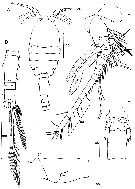 issued from : G.A. Boxshall & T.M. Iliffe in Sarsia, 1986, 71. [p.57, Fig.1]. Female (from Bermuda): A, habitus (dorsal); B, urosome (dorsal); C, genital complex (lateral); D, idem (ventral); E, A1 and rostrum (dorsal). Scales in micrometers. Nota: Prosome 5-segmented but with 1st free thoracic somite partly concealed beneath a carapace-like extension from posterior margin of maxilliped-bearing somite. Nauplius eye absent. Conspicuous anteroventrally directed rostrum prsent. Cone organs absent (see structure in Benthomisophria palliata. Last prosome somite capable of significant telescoping inside preceding somite, it is capable of dorsal flexion; Urosome 5-segmented with genital and 1st abdominal somites fused to form genital complex. Paired sensory setules present dorsally on 2nd to 4th urosomites. Caudal rami slightly longer than wide, armed with 4 plumose setae of differing lengths and 1 naked dorsal seta and 1 plumose lateral seta. A1 22-segmented and borne on an expanded basal pedestral which may represent a proximal antennulary segment; the aesthetascs present on the anteroventral surfaces of segmentI and V are large. Labrum small, bilobed and not fused to rostrum. P6 represented by 2 unequal setae on the operculum of each genital aperture.
|
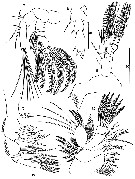 issued from : G.A. Boxshall & T.M. Iliffe in Sarsia, 1986, 71. [p.58, Fig.2]. Female: A, A2 (posterior); B, Md (anterior); C, Mx1 (anterior); D, Mxp (posterior); E, P5 (ventral). Scales in micrometers. Nota: A2 biramous; protopod comprising separate coxa and basis; endopod 2-segmented; exopod 6-segmented. Md with endopod 2-segmented and 5-segmented exopod. Mx1 with praecoxa and coxa separated by well developed articulation; praecoxal arthrite bearing 10 setae; coxal exite represented by 6 unequal plumose setae; coxal endite bearing 2 curved spiniform elements and 2 setae; basal endite bearing a curved spiniform element and 4 setae; basis and endopod apparently fused, incorporated 1st endopod segment armed with 3 setae at inner distal angle, 2nd armed with 6 plumose distal margin setae; exopod 1-segmented plate armed with 8 plumose setae around its distal margin and with proximal fringes of setules on inner and outer margins. Mxp 8-segmented; long 1st segment representing syncoxa. P5 uniramous, with 4 segments representing coxa, basis and 2-segmented exopod.
|
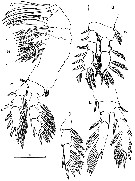 issued from : G.A. Boxshall & T.M. Iliffe in Sarsia, 1986, 71. [p.59, Fig.3]. Female: A, Mx2 (anterior); B, P1 (anterior); C, P2 (anterior); D, endopod of P3 (anterior); E, P4 (anterior). Scales in micrometers. Nota: Mx2 6-segmented; praecoxa with 2 distal endites, the 1st with 6 setae, the 2nd with 3 setae; coxa with 2 endites, the proximal with 3 and the distal with 2 plumose setae.; basis with single endite produced into strong claw bearing 1 slender and 3 stout setae proximally; ramus of 3 segments, each bearing a well developed inner margin seta, distal segment with 2 additional apical setae.
|
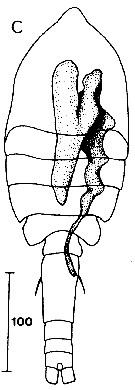 issued from : G.A. Boxshall & T.M. Iliffe in Sarsia, 1986, 71. [p.60, Fig.4, C]. Female: C, genital tract (dorsal). Scale bar in micrometer. There is a median ovary extending through most of prosome. It may represent the fused paired ovaries. A simple voluminous oviduct extends anteriorly from the midlateral surface of the ovary, curves ventrally, then passes posteriorly to its opening on that side of the genital complex. Nine females possessed full oviducts, visible through the body integument, of these 5 were on the right side (as illustrated in figure) and 4 were on the left.
|
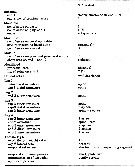 issued from : D. Jaume, G.A. Boxshall & W.F. Humphreys in Zool. J. Linnean Soc., 2001, 133. [p.22, Table 1]. Diagnostic characters of S. bivexilla. end- and exp- : endopodal and exopodal segments; (?): character states in need of verification. Nota : Character states apparently in discordance with original description by Boxshall & Iliffe (1986) derived from subsequent emendations of species description by Huys & Boxshall (1991) and Jaume & Boxshall (1986).
| | | | | NZ: | 1 | | |
|
Distribution map of Speleophria bivexilla by geographical zones
|
| | | | Loc: | | | Bermuda Is. (Roadside Cave) | | | | N: | 1 | | | | Lg.: | | | (616) F: 0,408-0,375; {F: 0,38-0,41} | | | | Rem.: | According to Boxshall & Iliffe (1986, p.60) this species is unique amongst misophrioids in possessing an asymmetrical female reproductive system. A most striking feature is the 2 pairs of long
strap-like aesthetascs on the A1; these hang down from the anteroventral surface of the limb and presumably come into contact with the substratum; they may provide chemosensory information to use in food location. This species is not adapted for gorging (see Benthomisophria palliata, Boxshall & Roe, 1980, p.34), since the carapace-like extension of the prosome is reduced so that it only partially covers the 1st pedigerous somite; the latter somite appears incapable of gross distension. | | | Last update : 16/06/2011 | |
|
|
 Any use of this site for a publication will be mentioned with the following reference : Any use of this site for a publication will be mentioned with the following reference :
Razouls C., Desreumaux N., Kouwenberg J. and de Bovée F., 2005-2026. - Biodiversity of Marine Planktonic Copepods (morphology, geographical distribution and biological data). Sorbonne University, CNRS. Available at http://copepodes.obs-banyuls.fr/en [Accessed January 07, 2026] © copyright 2005-2026 Sorbonne University, CNRS
|
|
 |
 |








